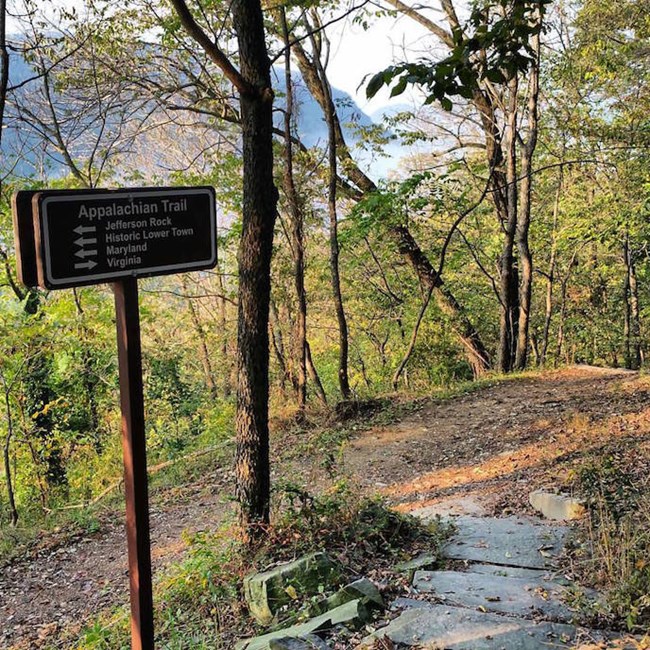Last updated: June 17, 2024
Article
NPS Geodiversity Atlas—Appalachian National Scenic Trail, CT, GA, MA, MD, ME, NC, NH, NJ, NY, PA, TN, VA, VT, and WV
Geodiversity refers to the full variety of natural geologic (rocks, minerals, sediments, fossils, landforms, and physical processes) and soil resources and processes that occur in the park. A product of the Geologic Resources Inventory, the NPS Geodiversity Atlas delivers information in support of education, Geoconservation, and integrated management of living (biotic) and non-living (abiotic) components of the ecosystem.

Introduction
The Appalachian National Scenic Trail (APPA) is a 3,523 km (2,189 mi)-long public footpath that traverses the scenic, wild, wooded, pastoral, and culturally significant landscapes of the Appalachian Mountains in parts of Connecticut, Georgia, Maine, Maryland, Massachusetts, New Hampshire, New Jersey, New York, North Carolina, Pennsylvania, Tennessee, Vermont, Virginia, and West Virginia (Figures 8a–8d). Established on October 2, 1968, APPA encompasses approximately 95,494 hectares (235,973 acres) and was designated as one of the first national scenic trails of the NPS. APPA is the longest continuously marked, maintained, and publicly protected trail in the United States, with its two endpoints at Mount Katahdin in Maine (northern terminus) and Springer Mountain in Georgia (southern terminus). The varied topography, ecosystem diversity, and numerous viewpoints along APPA showcase the Appalachian Mountains while providing a range of experiences for people of all ages and abilities who seek enjoyment, inspiration, learning, challenge, adventure, and self-fulfillment (National Park Service 2014).
Geologic Setting
APPA traverses some of the highest ridgelines of the Appalachian Mountains and crosses the richest assemblage of geologic units within the entire NPS. Along its course, the Appalachian Trail passes through three of the main physiographic provinces that make up the Appalachian Mountains: (1) Blue Ridge physiographic province; (2) Valley and Ridge physiographic province; and (3) New England physiographic province. The bedrock underlying APPA consists of all three major types of rock with ages spanning from the Precambrian through the Paleozoic, with minor occurrences of Jurassic-age intrusive rocks in New Hampshire. Many of the stratotypes reported here for APPA include geologic units shared with other park units located along the trail such as Great Smoky Mountains National Park (GRSM), Shenandoah National Park (SHEN), Delaware Water Gap National Recreation Area (DEWA), and Harpers Ferry National Historical Park (HAFE).
Regional Geology
The Appalachian National Scenic Trail passes through 14 states and several different Physiographic Provinces. The trail shares its geologic history and some characteristic geologic formations with a region that extends well beyond park boundaries. The southern portion of the travels the axis of the Blue Ridge Province with views and trail dipping into the Valley and Ridge, and Piedmont Provinces. The Northern portion of the trail passes through the New England Physiographic Province.
- Scoping summaries are records of scoping meetings where NPS staff and local geologists determined the park’s geologic mapping plan and what content should be included in the report.
- Digital geologic maps include files for viewing in GIS software, a guide to using the data, and a document with ancillary map information. Newer products also include data viewable in Google Earth and online map services.
- Reports use the maps to discuss the park’s setting and significance, notable geologic features and processes, geologic resource management issues, and geologic history.
- Posters are a static view of the GIS data in PDF format. Newer posters include aerial imagery or shaded relief and other park information. They are also included with the reports.
- Projects list basic information about the program and all products available for a park.
Source: NPS DataStore Saved Search 2707. To search for additional information, visit the NPS DataStore.
A NPS Soil Resources Inventory project has been started for Appalachian National Scenic Trail and can be found on the NPS Data Store.
Source: NPS DataStore Saved Search 2697. To search for additional information, visit the NPS DataStore.

Related Links
-
NPS Geodiversity Atlas—Great Smoky Mountains National Park, North Carolina and Tennessee
-
NPS Geodiversity Atlas—Blue Ridge Parkway, North Carolina and Virginia
-
NPS Geodiversity Atlas—Harpers Ferry National Historical Park, West Virginia, Virginia, and Maryland
-
NPS Geodiversity Atlas—Delaware Water Gap National Recreation Area, New Jersey and Pennsylvania
Related Articles
Appalachian National Scenic Trail
National Park Service Geodiversity Atlas
The servicewide Geodiversity Atlas provides information on geoheritage and geodiversity resources and values within the National Park System. This information supports science-based geoconservation and interpretation in the NPS, as well as STEM education in schools, museums, and field camps. The NPS Geologic Resources Division and many parks work with National and International geoconservation communities to ensure that NPS abiotic resources are managed using the highest standards and best practices available.Tags
- appalachian national scenic trail
- geology
- geodiversity atlas
- science
- nature
- west virginia
- vermont
- tenneessee
- pennsylvania
- new york
- new jersey
- new hampshire
- north carolina
- maine
- maryland
- massachusetts
- georgia
- connecticut
- northeast temperate network
- netn
- inventory
- interior region 1
- interior region 2
- north atlantic-appalachain
- south atlantic gulf
- grd
